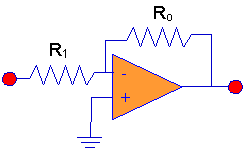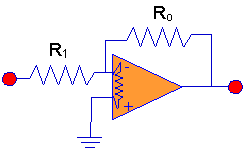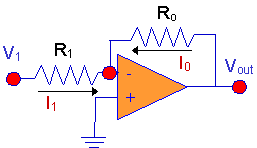The Inverter - A Simple Operational Amplifier Circuit
Operational amplifiers can be used to perform mathematical operations on voltage
signals such as inversion, addition, subtraction, integration, differentiation,
and multiplication by a constant. You need to understand how to figure out
what an operational amplifier circuit does. We will start with a simple
circuit so that we can examine a method that will permit you to figure out how
these circuits work and then you will have a more general method you can use for
more complex circuits. So, you have two goals in this section.

Given an inverting amplifier op-amp circuit with resistor values,

Be able to compute the gain of the circuit.

Given an operational amplifier op-amp circuit similar to the inverting
amplifier,

Be able to compute the output voltage of the circuit in terms of the signals
and electrical elements in the circuit.
Analyzing the Inverting Amplifier
The
circuit we will examine is shown below. This circuit amplifies a voltage
by a factor (- Ro / R1). What is
important in this circuit is that it amplifies by almost exactly (-Ro
/R1) so that the gain of the circuit can be controlled
precisely by controlling the resistor values precisely. The gain of the
circuit will not depend upon paramters of the "Op-Amp". We'll analyze this
circuit to get a mathematical prediction of how it works.

Note: The power supply
connections are not shown. For the operational amplifier to function
properly you will need to supply power to it. Also, note that the input labelled "+" is referred to as the
non-inverting input, and the input labelled "-" is referred to as the
inverting input. The operational amplifier amplifies the difference
between the non-inverting input and the inverting input. In other words,
the output of the operational amplifier is:
Because the operational amplifier amplifies the
difference between the two voltages - rather than a single voltage - the
operational amplifier is a differential amplifier.
The
operational amplifier has a long history. It first appeared in vacuum tube
manifestations in the 1950s. These amplifiers were heavy, expensive and
prone to failure. They usually required a power supply that most normal
people could not lift. The amplifiers cost about a hundred dollars, and
the supplies several hundred in an era when a hundred dollars was worth much
more than today's value. In the 1960s transistorized versions of
operational amplifiers came on the market, and in the middle to late 1960s the
first integrated circuit operational amplifiers came on the market.
(Although different technologies were used at different times, the amplifiers
had characteristics in common that marked them as operational amplifiers even
though built in widely different forms!)
In
this era of team engineering it is interesting to note that one individual,
Robert Widlar, was responsible for the development
of the integrated circuit operational amplifier in a form that led to wide
acceptance. Today, thanks to Widlar and many others operational amplifiers
are available for less than 25 cents and the operational amplifier is probably
the most widely used analog integrated circuit.
Widlar is known not just for his creativity, but also for his zany antics.
Of course, those two characteristics might just go together. When National
Semiconductor went into a period of austerity, and stopped mowing the grass, Bob
Widlar brought a sheep and turned it loose to graze.
Analysis Of The Inverting Amplifier
To
analyze the inverting amplifier, we start by making an assumption that the
output voltage, Vout, is some "reasonable" value - a value
somewhere between the values of the positive and negative power supply voltages. That may well
seem like an odd place to start, but we can begin to look at the consequences of
making that assumption.
For
example, we might have an output voltage of ten (10) volts. We can figure out
what input voltage caused that output voltage of ten volts. If the gain of
the operational amplifier is 100,000, then the input difference, (V+ - V-), must
be 10/100,000 or .00001 volts. That's 100 microvolts, and it's pretty darn
small.
Notice what happens here. This assumption that the difference between the
inverting and noninverting input voltages is just a consequence of the
very high gain of the operational amplifier. It's not special to
this circuit. It's a general idea that we can make use of in other
amplifier circuits.
For
all practical purposes that voltage is close enough to zero that we will call it
zero when we calculate how the circuit behaves. We know it isn't zero, but
it has such a small value that it will not affect any of our calculations.
You'll need to remember the logic here.
-
If the output of the
operational amplifier is some reasonable value (usually ten volts or less,
either positive or negative, as long as the amplifier isn't saturated.
Then all bets are off.),
-
And, if the operational
amplifier has a really high gain (and remember 100,000 is probably a low value
of the gain for typical amplifiers),
And, note
the following:
-
For the voltage to be zero the
gain of the amplifier would have to be infinite. When people discuss this
assumption, they often refer to it as the infinite
gain assumption.
-
What the infinite gain
assumption reduces to is that we can consider the voltage difference between the
two inputs to be zero.
For all
practical purposes that voltage is close enough to zero that we will call it
zero when we calculate how the circuit behaves. We know it isn't zero, but
it has such a small value that it will not affect any of our calculations.
Since
the difference between the operational amplifier input voltages are practially
zero and the internal input resistance is very large, we can make the
assumption that the current flowing into the amplifier through either of the
input terminals is so small as to be negligible. Most of the time that's a
good assumption because:
Here is a modified circuit diagram that shows the
input resistance of the operational amplifier. You can visualize the input
resistance as a resistor connected between the input terminals of the
operational amplifier.

Let's
take a minute to summarize the few assumptions we have made so far.
-
The output voltage, Vout,
is within the value between the positive and negative voltage supply. It's
a "reasonable" value.
-
The input difference, (V+
- V- ) is small enough that we can consider the value to be
approximately zero. This is due to large gain of the amplifier - the
infinite gain assumption. We will assume that
the input voltage difference is zero.
-
Since we will treat the input
difference as zero, and assume input resistance (the resistance between the
non-inverting and inverting inputs) is infinte, then the current flowing through
both of the inputs of the amplifier will also be so small that it is negligible.
We will assume that no current enters the input terminals of the op-amp.
Assuming
that the input difference is small, we can write KCL at the inverting node:
(Notice the little red dot at the inverting node in the circuit diagram.)
(Note also, that we have defined two voltages, V1 and Vout
that are both measured with respect to the ground.)

Here's
the KCL equation using the assumption that the voltage at the amplifier input -
at the input node - is zero.
I1
+ I0 = 0
Technically, we can write KCL in terms of all the
voltages involved (taking V+ and V-
as the voltages - with respect to ground - at the "+" and "-" terminals
respectively). Doing that we obtain:
( V1
- V- )/ R1 + ( Vout
- V- )/ R0 = 0
However, since we assume that there is no voltage difference between V+
and V- , we can replace V- with V+
and we have the inverting input terminal connected to ground, so V-
= 0. That means we get:
V1
/ R1 + Vout / R0
= 0
|

